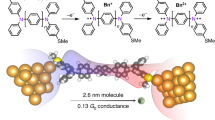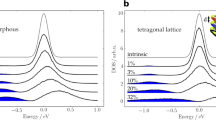Abstract
MOST molecular conductors rely on charge transfer to create carriers. For example, the ET salts1 are hole-doped whereas the C60 salts2 are electron-doped. Neutral radical species in which bands are formed by π-orbital overlap would be expected to have half-filled bands and thus to be conducting3, but no such metals have yet been reported. Here we report the synthesis and characterization of a molecular conductor which combines both of these approaches: energy bands are formed from one-dimensional stacks of neutral π-radicals, and the material is rendered conducting by electron transfer from the conduction band following doping with an acceptor. The radical species is the l,4-phenylene-bis(dithiadiazolyl) diradical 1,4-[(S2N2C)C6H4(CN2S2)] (2 in Fig. 1), reaction of which with iodine vapour leads to crystals of [2][I]. At low temperatures this compound is essentially a diamagnetic insulator, but above 200 K the conductivity and magnetic susceptibility increase markedly, and at room temperature the conductivity reaches l00 S cm−1, which is comparable to that shown by conventional molecular charge-transfer salts.
This is a preview of subscription content, access via your institution
Access options
Subscribe to this journal
Receive 51 print issues and online access
$199.00 per year
only $3.90 per issue
Buy this article
- Purchase on Springer Link
- Instant access to full article PDF
Prices may be subject to local taxes which are calculated during checkout
Similar content being viewed by others
References
Williams, J. M. et al. Organic Superconductors (Prentice-Hall, Englewood Cliffs, 1992).
Haddon, R. C. et al. Am. chem. Soc. Symp. Ser. 481, 71–89 (1992).
Haddon, R. C. Nature 256, 394–396 (1975).
Soos, Z. G., Keller, H. J., Moroni, W. & Nothe, D. Ann. N.Y. Acad. Sci. 313, 442–458 (1978).
Nakasuji, K. et al. J. Am. chem. Soc. 111, 9265–9267 (1989).
Schultz, A. J. et al. Inorg. Chem. 26, 3757–3761 (1987).
Haddon, R. C. et al. J. Am. chem. Soc. 100, 7629–7633 (1978).
Haddon, R. C., Chichester, S. V., Stein, S. M., Marshall, J. H. & Mujsce, A. M. J. org. Chem. 52, 711–712 (1987).
Oakley, R. T., Reed, R. W., Cordes, A. W., Craig, S. L. & Graham, J. B. J. Am. chem. Soc. 109, 7745–7749 (1987).
Hayes, P. J., Oakley, R. T., Cordes, A. W. & Pennington, W. T. J. Am. chem. Soc. 107, 1346–1351 (1985).
Cordes, A. W., Haddon, R. C. & Oakley, R. T. in The Chemistry of Inorganic Ring Systems (ed. Steudel, R.) 295–321 (Elsevier, Amsterdam, 1992).
Banister, A. J. & Rawson, J. M. in The Chemistry of Inorganic Ring Systems (ed. Steudel, R.) 323–348 (Elseuier, Amsterdam, 1992).
Andrews, M. P. et al. J. Am. chem. Soc. 113, 3559–3568 (1991).
Cordes, A. W. et al. J. Am. chem. Soc. 113, 582–588 (1991).
Liblong, S. W., Oakley, R. T. & Cordes, A. W. Acta crystallogr. C46, 140–142 (1990).
Torrance, J. B. Ann. N.Y. Acad. Sci. 313, 210–233 (1978).
Author information
Authors and Affiliations
Rights and permissions
About this article
Cite this article
Bryan, C., Cordes, A., Fleming, R. et al. Conducting charge-transfer salts based on neutral π-radicals. Nature 365, 821–823 (1993). https://doi.org/10.1038/365821a0
Received:
Accepted:
Issue Date:
DOI: https://doi.org/10.1038/365821a0
This article is cited by
-
Organic radicals in single-molecule junctions
Science China Materials (2024)
-
Recent Advances of Stable Phenoxyl Diradicals
Chemical Research in Chinese Universities (2023)
-
Mixed valence salts based on carbon-centered neutral radical crystals
Communications Chemistry (2018)
Comments
By submitting a comment you agree to abide by our Terms and Community Guidelines. If you find something abusive or that does not comply with our terms or guidelines please flag it as inappropriate.



